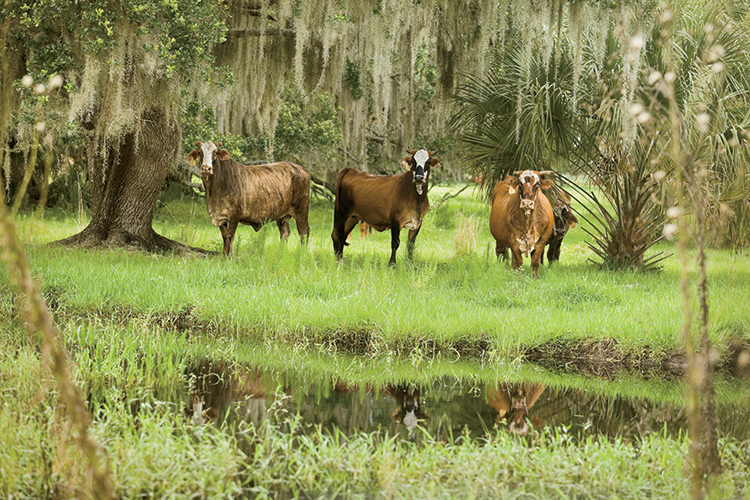Home > Florida > Florida Crops & Livestock > Florida is First in Cattle
Florida is First in Cattle
In partnership with: Florida Department of Agriculture and Consumer Services

While tourists visit Walt Disney World, Henry Kempfer and his family tend their 116-year-old cattle ranch within an hour of the Magic Kingdom.
The sixth generation of Kempfers is growing up on the family’s 25,000-acre ranch near Deer Park, where the family manages a herd of 2,500 cows and their calves. They have raised commercial beef cattle since 1898 and purebred Brahman beef cattle since 1978.
Kempfer Cattle Co. represents one of Florida’s 18,433 beef cattle ranches, a quantity that ranks 12th in the nation. Likewise, Florida ranks 12th in beef cow inventory with 877,000 beef cows as of Jan. 1, 2014, according to the National Agricultural Statistics Service.
Access to nearly year-round grass gives Florida a significant advantage in profitable beef cattle production. In fact, three of the nation’s five largest beef cow-calf ranches operate in Florida, not far from tourist attractions like Walt Disney World and Universal Studios.
See More: Operation Outdoor Freedom Connects Wounded Vets with Nature
Despite this, the state’s beef cattle production proves a quiet, yet highly impactful industry. Total economic effects of cattle ranching total $2.1 billion annually, and employment exceeds 17,000, according to the Florida Department of Agriculture and Consumer Services. Far more Florida farms raise beef cattle than grow oranges. Still, the industry goes largely unnoticed.
“I think we are guilty of staying on ranches to maintain the way of life we enjoy,” says Jim Handley, executive vice president of the Florida Cattlemen’s Association. “While we’ve not had our gates locked to the public, we have not been as proactive in our outreach. But that is changing.”

First For Beef
“Florida beef cattle have been around since 1521, when Juan Ponce de Leon brought cattle to the New World,” says Chris Denmark, development representative for the Florida Department of Agriculture and Consumer Services. “These were the first cattle to set hoof in the Continental United States.”
He adds, “Today, it’s common to find fifth- and sixth-generation cattle ranchers running these modern-day businesses. Cell phones and tablets aid in management of beef cattle herds. Yet, ranchers also use horses and dogs to herd cattle, as some ranch families have for hundreds of years.”
Most of Florida’s cattlemen run cow-calf operations, on which they care for cows that give birth to calves. A majority of ranchers raise those calves to about 500 pounds and transport them to feedlots in the Midwest where grain is prevalent, Denmark says. Ranchers may sell through livestock markets, establish direct contracts or retain calf ownership with feedlots.

Legacy And Land Stewardship
Florida cattlemen manage grassland use and control exotic and invasive plants, Handley says. They manage water resources and monitor wildlife activity to maximize hunting opportunities. Meanwhile, they care for threatened and endangered species and their unique habitat in the Sunshine State. In fact, Florida’s residents and tourists need these grasslands as much as its cattlemen.
“In a state with a population of 19 million, we need the water recharge areas that ranchlands represent,” Handley says. Henry Kempfer hears public discussions about sustainability and stands by the long-term environmental awareness of their sixth-generation cattle operation.
“We’ve proven we can be here and take care of our land,” he says. “Our No. 1 source of income is cattle. We rely on our land to make an income. If we don’t take care of it, it’s not going to be there for future generations to say the
same thing.”
In that spirit, Kempfer Cattle Co. strives for top-quality cattle, breeds progressively and willingly adopts changes to make improvements.
“For years, Florida was looked down upon because the state had a lot of room to grow in quality genetics,” Kempfer says. “Today, we are producing cattle that will perform with those Western and Midwestern cattle.”



